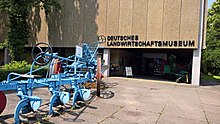German Agricultural Museum
The German Agricultural Museum (DLM) in Stuttgart-Hohenheim is considered to be one of the most extensive collections of agricultural implements and machines in German-speaking countries. On a total of 5,700 square meters of covered exhibition space, the DLM documents the technical change in agriculture from simple handheld devices to modern self-propelled vehicles. The museum concept represents the developments in the history of production and documents the constant change in agricultural history as well as their causes and connections.
The core of the DLM is the former model and equipment collection, which has been continuously built up since the Hohenheim agricultural equipment factory was founded in 1819. The idea of an agricultural museum was born on the occasion of the 1958 world plowing competition , when the Hohenheim plow collection was presented to the public for the first time in decades. With the construction of the Institute for Agricultural Engineering in 1965, the university's own agricultural collection was given a permanent exhibition space. Three more exhibition halls were added from 1994 to 2004 at the branch in Filderhauptstrasse. Both locations are on the campus of the University of Hohenheim. The university is also the sponsor of the DLM. As a partner institution, the German Agricultural Museum in Blankenhain Castle / Saxony documents the agricultural history of the GDR .
Collections
Model collection
In close cooperation with the agricultural institute, the Hohenheim farm equipment factory was instrumental in the development of agricultural equipment in the mid-19th century. In addition to many improved tools for cultivating the soil, the factory at that time created a large number of meticulously manufactured models of agricultural machines and devices. The detailed objects served generations of farmers and craftsmen as a template for recreating the agricultural achievements of yore. At the same time, the Hohenheim teachers used the models as illustrative and teaching material for their lessons. As a contribution from the Kingdom of Württemberg , the importance of the models was recognized with high awards at the world exhibitions in Paris and London. Many of the 1,000 or so miniatures are still functional today and testify to the constant efforts to improve working conditions in rural areas.
Steam plow
Even before entering the museum, visitors are greeted with the technical achievements of yore. In front of the entrance there is a tipping plow weighing tons from the Wroclaw manufacturer Kemna (built in 1921). The associated Heucke steam locomotives are also represented in the museum: operated by the Regensburger Dampfpflug Gesellschaft until 1965, the machines, each weighing twenty tons, are now carefully restored in the center of the tractor hall of the DLM.
Tractor collection
Stuttgart -Deutsches Landwirtschaftsmuseum- 2018 by-RaBoe m18.jpg The tractors of the DLM enjoy almost cult status, especially among tractor enthusiasts . On over 1,400 square meters you can see more than 100 tractors, most of which have made agricultural history. Well-known brands such as Fendt, Hanomag, Lanz, MB or Porsche are represented as well as the makes of smaller manufacturers. From the wood gasifier tractor from the 1940s to the modern 250 HP system tractor, all eras are available.
building
Cheret Pavilion
In 1994, the DLM was able to expand its exhibition space for the first time with the wooden pavilion designed by Stuttgart architect Prof. Peter Cheret. The wooden building, made using a pole construction, served as a representative building for the state government at the 1993 International Garden Show in Stuttgart's Rosenstein Park . The approximately 1,300 square meter structure was dismantled in the same year in order to be rebuilt a second time in the Filderhauptstrasse. In 1994, Prof. Cheret received the Baden-Württemberg Timber Construction Prize for architecture made from industrially prefabricated parts.
Harvest hall
The technical progress in the grain and stalk forage harvest is the subject of the harvest hall of the DLM. Starting with the American McCormick's first grain mower , the development of the self-propelled combine harvester can be followed on 1,000 square meters. With significant support from the entrepreneur Helmut Claas , the harvest hall was completed in 2004. The harvest hall as well as the tractor hall were designed by the Stuttgart architect Prof. Friedrich Wagner. With the stipulation of an economical and representative museum architecture, the halls consist mainly of the materials glued laminated wood, glass and transparent plastics.
Field day
Once a year, agricultural history comes to life again at the Hohenheim Field Day. Under a certain motto, tried and tested devices from back then show how they work and document the development of agricultural technology live. At the same time, the demonstration of modern machines establishes a reference to current agricultural technology. The topics of the field days cover the entire range of activities from tillage to sowing, plant protection and harvest.
Web links
- Official website of the DLM Hohenheim
- Internet presence of the University of Hohenheim
- Common side of both German agricultural museums
Coordinates: 48 ° 42 ′ 36 ″ N , 9 ° 12 ′ 0 ″ E




